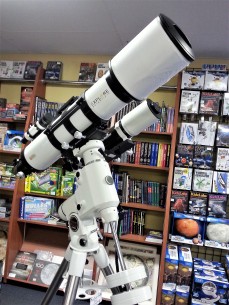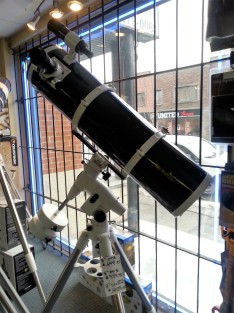There are 3 basic types of telescopes categorized by the way light enters the objective and is focused at the eyepiece…the refractor, reflector and catadioptric.
The Refractor

-
Explore Scientific Refractor
The refractor uses a series of lenses to refract or bend the light coming through the objective so that it converges at the other end where the eyepiece is located. In order to achieve more comfortable viewing a star diagonal is used.
Consider the following:
-
The tube is closed to the air currents and this protects the lenses and helps cut down air currents inside the tube which degrade the viewing or image
-
Collimation is rarely required…lenses are permanently aligned
-
Excellent for planetary, binary stars viewing
-
Degradation does not occur appreciably with age unlike telescopes that have mirrors
-
The apochromatic designs include an additional lens system which serves to alleviate chromatic aberration but is more costly
-
Transmission of light (related to detail observed) is around 90%
-
A diagonal mirror is usually used with this design of telescope and can serve to further diminish light transmission, although still significantly better than all the other telescope designs
-
Excellent for planetary, binary stars viewing and out performs the other designs on a “hazy” night
However…
-
Due to its long and narrow design the long thin tube of the refractor is more susceptible to movement caused by the wind
-
The most expensive type of telescope
-
Requires a longer cooling period that reflectors due to closed tube system
-
Less suited for faint DSO (Deep Sky Objects)
-
Usually heavier than the other types of telescopes
-
The long focal length models make it more difficult to place the observer in a comfortable position for viewing
-
Suffers from chromatic aberration in the achromatic designs
-
The apochromatic designs include an additional lens system which serves to alleviate chromatic aberration but is more costly
The Newtonian Reflector

-
Skywatcher Reflector
This type of telescope has no lenses. In this design a parabolic primary mirror reflects the incoming light coming through the objective onto a secondary mirror which in turn reflects and focuses the light onto the eyepiece.
Consider the following:
-
Excellent for viewing DSO such as Nebula, galaxies and star clusters
-
Good for astrophotography of DSO but more difficult than catadioptric designs in terms of focusing
-
Reasonably good for viewing planets and Moon
-
Transmission of light (related to detail observed) is around 77 – 80%
-
Portability is favorable up to focal lengths of 1000mm
-
Due to not having lenses there is no chromatic aberration
However…
-
Requires regular collimation
-
Suffers from optical aberration or coma but corrector lenses can be used to alleviate this problem
-
The tube is open and exposed to air currents which make it more susceptible to image degradation or “shaky viewing” due to uneven changes in temperature
-
The quality of the coating on the mirrors is very important to the quality of the image and will help maintain the mirrors for many years without the need for re-coating
-
The quality of the coating on the mirrors is very important to the quality of the image and will help maintain the mirrors for many years without the need for re-coating
-
As much a 1-1.5% reflectivity loss per year can occur due to oxidation of the aluminum coating of the mirrors.
-
Light loss (relates to quality of image and viewing) is greater than in refractors due to a mirror instead of a lens design and the central obstruction. Depending on the specific design and materials used light loss can be as much as 30%
-
Eyepiece location is in the front of the tube and may be in an awkward position (depending on location of object viewed in the sky). This would require loosening the rings holding the telescope tube and rotating it to a more comfortable level for the observer
The Catadioptric

-
Meade Lx200, 10 inch
see also: Types of Catadioptric Telescopes
This telescope design is a hybrid of the refractor and reflector. Lenses and mirrors are uses to bend, reflect and focus the light onto the eyepiece. This design allows the actual length of the telescope to be shorter than either the refractor or reflector while at the same time providing increased magnification. In other words a much longer equivalent focal length is obtained in a shorter tube.
Consider the following:
-
Excellent for DSO viewing and imaging
-
Good for planetary and lunar viewing and imaging
-
Transmission of light (related to detail observed) is around 70 -75%
-
More portable due to shorter tube
-
Tube is sealed protecting the optics
-
Generally more comfortable eyepiece position
-
Reduces optical aberrations to minimal
-
Essentially no chromatic aberration
-
Excellent for astrophotography as it has the best focusing capability of any other design and because of the fact that higher magnifications are possible (comparing the equivalent length and size to refractors and reflectors)
-
Costs more than a reflector but get more aperture than a refractor for same price
However…
-
More expensive than reflectors
-
Requires collimation
-
Suffers from a secondary mirror obstruction similar to reflectors with light loss
-
A sealed tube means that it has to be “cooled” longer than a reflector
-
Some curvature of field of view which is eliminated in some of the more expensive Schmidt-Cassegrain models
-
The quality of the coating on the mirrors is very important to the quality of the image and will help maintain the mirrors for many years without the need for re-coating
-
As much a 1-1.5% reflectivity loss per year can occur due to oxidation of the aluminum coating of the mirrors
Web Site Map:
Astronomy Notebook
The Moon
Images And Videos
Equipment and Setup
Notes on Equipment
Astrophotography
An Overview Of The Methods In Astrophotography
Links
Contact
Thanks to: La Maison de l’Astronomie and Lire La Nature Astonomie Plus, for allowing images to be taken of the telescopes on this page.